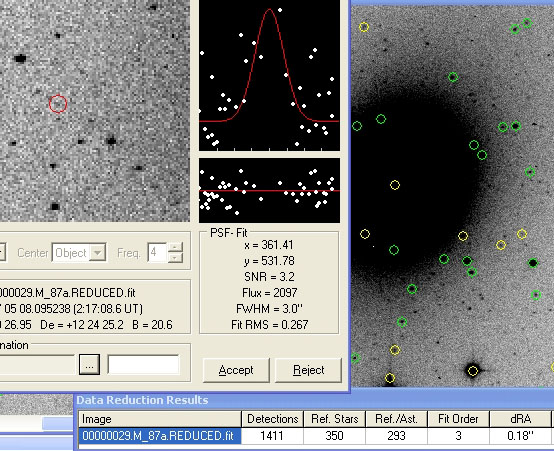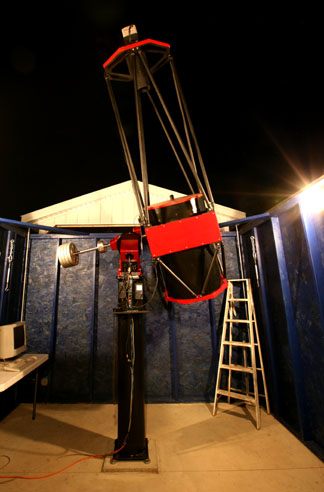
ASTRONOMICAL RESEARCH INSTITUTE
ASTRONOMICAL RESEARCH OBSERVATORY

Photo by John Stone
The Astro-Research 24 inch carbon fiber OTA on a SB Paramount ME
Our quest was to place the largest telescope possible on the current Software Bisque Paramount ME that was located in Astronomical Research Observatory I. The design, is a 24 inch ( 0.61m ) astrograph that is similar to the 32 inch (0.81m) telescope we designed and built previously. Mike Lockwood owner of Lockwood Custom Optics also made the 24" mirror for this telescope and the final results speak volumes literally. In the past year over 200 observations were published in the MPECs with this telescope to unfiltered magnitude 22.2. As an astrograph, the camera operates at the prime focus, so no secondary mirror is used. This eliminates an additional optical surface which may introduce errors and eliminates light loss due to absorption by an additional optical component. The difference on this project compared to the 32 inch telescope is the use of light weight carbon fiber technology to create an optical tube assembly that weighs less than 150 lbs. With extensive use of carbon fiber and aluminum tubing, this allowed the production of a telescope weighing only 143 pounds (65 kilograms). This is 7 lbs less than the design weight limitation of the SB Paramount ME. Truss tubes, mirror cell, and camera mount were all made using carbon fiber to reduce weight. Our secondary goal was to eliminate nearly all the expansion and contraction problems associated with focusing using metallic truss tubes. No data has been obtained yet for variations in focus based on the expansion coefficient of the carbon fiber truss tubes. Analysis of the structural properties of carbon fiber truss tubes were quite surprising with less than 12 arc/sec of total flexure from horizon to horizon. The primary mirror is a solid Pyrex blank 24 inches ( 0.61m ) in diameter, 1.6 inches thick, figured to better than 1/16 wave with a weight of just 59 pounds (26.82 kg) to keep the overall optical tube assembly light weight.
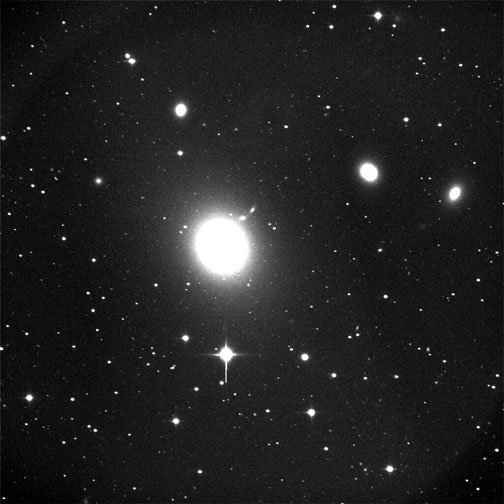
First light image 24 inch telescope M87 - May 8th 2007
These images were taken during 8-12 mph winds, a testament to the rigidity of the Paramount ME working at full capacity. Light cirrus clouds no moon. Exposure time - 180 seconds. See magnitude measures.
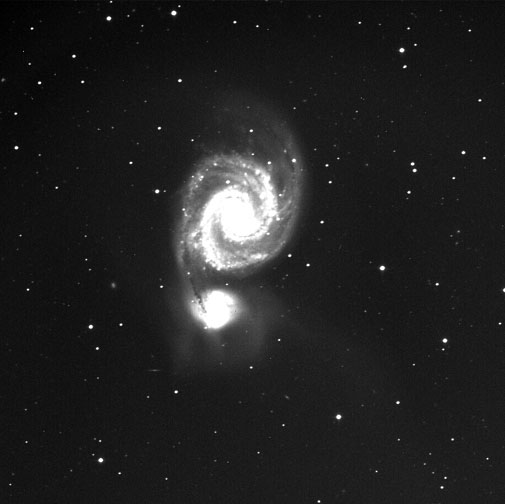
24 inch telescope image of M51 - 180 seconds
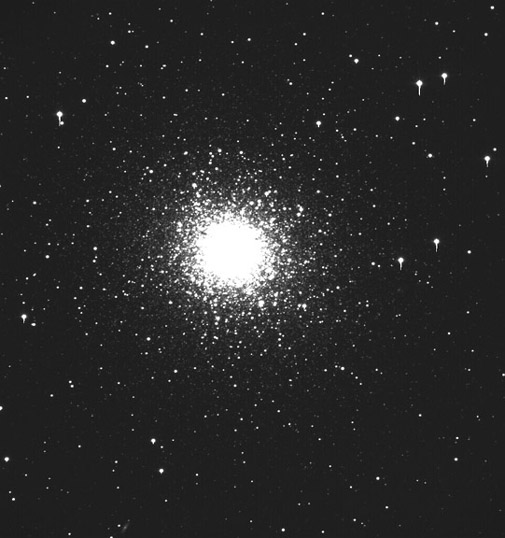
24 inch telescope image - M 13 - 300 second image.
Note at the lower left is galaxy IC 4617 at magnitude 16.0 Blue
We work on research images at ARI so none of the images were taken with filters to produce color. Note that there is slight elongation of the star images due to wind. Exposure time - 180 Seconds
Carbon Fiber 24 inch telescope (0.61m) Components
carbon fiber truss tubes, mirror cell triangle, camera mount baffle tube
24 inch Instrumentation Design
Design Analysis For the Astro-Research (0.61 meter) 24" f/5.32 Telescope
| Length of OTA w/camera installed | 117.75 inch (299.1 cm) | |
| Outside Diameter of OTA | 31.10 inch (79 cm) |
| Primary Mirror Diameter | 24 inch (0.61 meter) | |
| Focal Length with Televue ParaCorr | 125.78 inches (3195mm) | |
| Central Obstruction 6.55" Prime Focus CCD Camera | 27.1% | |
| Weight | 143 lbs | |
| Carbon Fiber - Aluminum Construction | ||
| Mirror Specifications | ||
| Focal Ratio | f/4.5 | |
| Waves Of Correction Primary Mirror | 8.169 | |
| Mirror Sagitta | 0.294 | |
| Airy Disk Size (Microns) | 6.8 | |
| Aperture Size In Square Inches | 452 sq. inches | |
| Coatings - Spectrum Coatings | 96% reflective | |
| Telescope Specifications | ||
| Light Gathering X Human Eye | 9,216 | |
| 5 min exp. Approx CCD Limiting Magnitude 90% Probability | 21.24 unfiltered | |
| 5 min exp. Approx CCD Limiting Magnitude 10% Probability | 21.54 unfiltered | |
| Theoretical Resolution | 0.190" | |
| Field Of View With a SBIG STL1001E | 26.40' x 26.40' | |
| CCD Resolution of the SBIG STL 1001E (24 micron pixels) | 1.55 arc sec/pixel | |
| Tube Design | Open Truss | |
| Optical Baffling | Primary, Camera | |
| Coma Correction | Televue ParaCorr STL Series | |
| Mount Specifications | ||
| Mount Type - GEM | Software Bisque Paramount ME |
Other first night images and data.
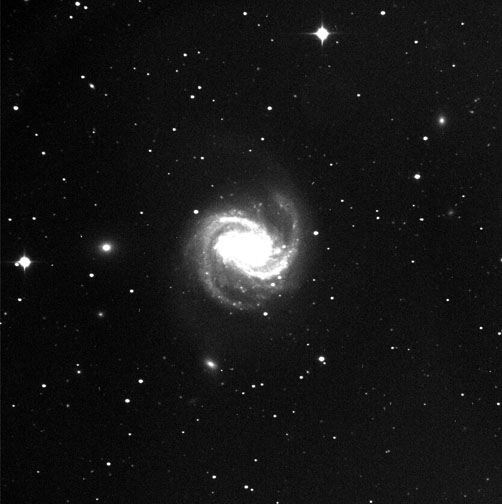
24 inch telescope M 100 Exposure - 180 Seconds
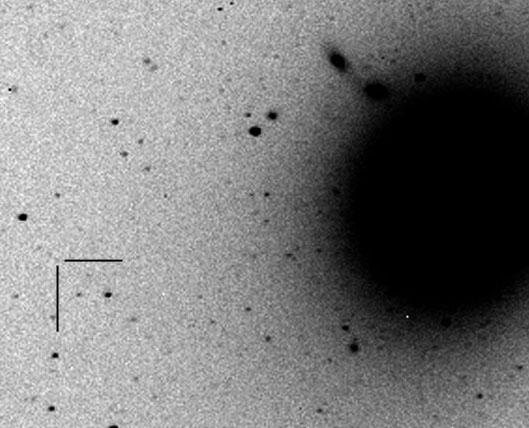
M87 first light image - Limiting magnitude 21.1 in a 180 second exposure. Reference above is a 20.6 magnitude star based on 290 photometric reference stars and image has been flipped for astrometry and photometry. Above image has been enlarged 200% to show detail. Additional data below.
